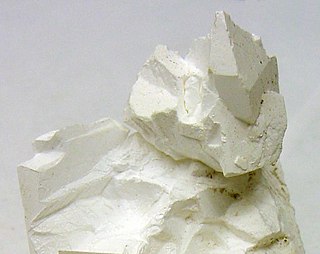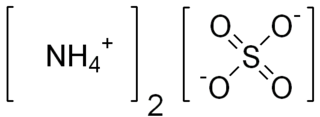
In chemistry, a salt or ionic compound is a chemical compound consisting of an assembly of positively charged ions (cations) and negatively charged ions (anions), which results in a compound with no net electric charge. The constituent ions are held together by electrostatic forces termed ionic bonds.

Intravenous therapy is a medical technique that administers fluids, medications and nutrients directly into a person's vein. The intravenous route of administration is commonly used for rehydration or to provide nutrients for those who cannot, or will not—due to reduced mental states or otherwise—consume food or water by mouth. It may also be used to administer medications or other medical therapy such as blood products or electrolytes to correct electrolyte imbalances. Attempts at providing intravenous therapy have been recorded as early as the 1400s, but the practice did not become widespread until the 1900s after the development of techniques for safe, effective use.

Colposcopy is a medical diagnostic procedure to visually examine the cervix as well as the vagina and vulva using a colposcope.

Potassium alum, potash alum, or potassium aluminium sulfate is a chemical compound first mentioned under various Sanskrit names in Ayurvedic medicinal texts such as charak samhita, sushrut samhita, and ashtang hridaya; is chemically defined as the double sulfate of potassium and aluminium, with chemical formula KAl(SO4)2. It is commonly encountered as the dodecahydrate, KAl(SO4)2·12H2O. It crystallizes in an octahedral structure in neutral solution and cubic structure in an alkali solution with space group Pa3 and lattice parameter of 12.18 Å. The compound is the most important member of the generic class of compounds called alums, and is often called simply alum.

Barium chloride is an inorganic compound with the formula BaCl2. It is one of the most common water-soluble salts of barium. Like most other water-soluble barium salts, it is a white powder, highly toxic, and imparts a yellow-green coloration to a flame. It is also hygroscopic, converting to the dihydrate BaCl2·2H2O, which are colourless crystals with a bitter salty taste. It has limited use in the laboratory and industry.

Potassium sulfate (US) or potassium sulphate (UK), also called sulphate of potash (SOP), arcanite, or archaically potash of sulfur, is the inorganic compound with formula K2SO4, a white water-soluble solid. It is commonly used in fertilizers, providing both potassium and sulfur.

The term chevra kadisha gained its modern sense of "burial society" in the nineteenth century. It is an organization of Jewish men and women who see to it that the bodies of deceased Jews are prepared for burial according to Jewish tradition and are protected from desecration, willful or not, until burial. Two of the main requirements are the showing of proper respect for a corpse, and the ritual cleansing of the body and subsequent dressing for burial. It is usually referred to as a burial society in English.

Ammonium sulfate (American English and international scientific usage; ammonium sulphate in British English); (NH4)2SO4, is an inorganic salt with a number of commercial uses. The most common use is as a soil fertilizer. It contains 21% nitrogen and 24% sulfur.

The Warsaw Jewish Cemetery is one of the largest Jewish cemeteries in Europe and in the world. Located on Warsaw's Okopowa Street and abutting the Christian Powązki Cemetery, the Jewish necropolis was established in 1806 and occupies 33 hectares of land. The cemetery contains over 250,000 marked graves, as well as mass graves of victims of the Warsaw Ghetto. Although the cemetery was closed down during World War II, after the war it was reopened and a small portion of it remains active, serving Warsaw's existing Jewish population.
Bereavement in Judaism is a combination of minhag (traditions) and mitzvah (commandments) derived from the Torah and Judaism's classical rabbinic literature. The details of observance and practice vary according to each Jewish community.

A cutman is a person responsible for preventing and treating physical damage to a fighter during the breaks between rounds of a full contact match such as a boxing, kickboxing or a mixed martial arts bout. Cutmen typically handle swelling, nosebleeds and lacerations. In addition to degrading a fighter's performance, the rules of combat sports stipulate that these injuries can be a cause for premature match stoppage, counting as a loss to the injured fighter. The cutman is therefore essential to the fighter, and can be a decisive factor in the outcome of the match.
Indium(III) sulfate (In2(SO4)3) is a sulfate salt of the metal indium. It is a sesquisulfate, meaning that the sulfate group occurs 11/2 times as much as the metal. It may be formed by the reaction of indium, its oxide, or its carbonate with sulfuric acid. An excess of strong acid is required, otherwise insoluble basic salts are formed. As a solid indium sulfate can be anhydrous, or take the form of a pentahydrate with five water molecules or a nonahydrate with nine molecules of water. Indium sulfate is used in the production of indium or indium containing substances. Indium sulfate also can be found in basic salts, acidic salts or double salts including indium alum.

Chesed Shel Emet is a Jewish voluntary organisation that is found in various forms around the world.

Ammonium iron(III) sulfate, NH4Fe(SO4)2·12 H2O, or NH4[Fe(H2O)6](SO4)2·6 H2O, also known as ferric ammonium sulfate (FAS) or iron alum, is a double salt in the class of alums, which consists of compounds with the general formula AB(SO4)2 · 12 H2O. It has the appearance of weakly violet, octahedrical crystals. There has been some discussion regarding the origin of the crystals' color, with some ascribing it to impurities in the compound, and others claiming it to be a property of the crystal itself.

Sanhedria Cemetery is a 27-dunam (6.67-acre) Jewish burial ground in the Sanhedria neighborhood of Jerusalem, adjacent to the intersection of Levi Eshkol Boulevard, Shmuel HaNavi Street, and Bar-Ilan Street. Unlike the Mount of Olives and Har HaMenuchot cemeteries that are located on the outer edges of the city, Sanhedria Cemetery is situated in the heart of western Jerusalem, in proximity to residential housing. It is operated under the jurisdiction of the Kehilat Yerushalayim chevra kadisha and accepts Jews from all religious communities. As of the 2000s, the cemetery is nearly filled to capacity.

The Shaare Zedek Cemetery is a small Jewish burial ground located behind the first Shaare Zedek Hospital in Jerusalem. Originally used by the hospital as farmland for grazing milk cows, the area was converted into a temporary cemetery during the Arab siege of Jerusalem in 1948. Approximately 200 burials were conducted here between March and October of that year. Most graves were transferred to permanent cemeteries after the war, but a handful remain, notably those of several prominent Jerusalem rabbis and the founding director of Shaare Zedek Hospital, Dr. Moshe Wallach.
Misaskim is an American Orthodox Jewish not-for-profit organization that provides services for the care of the dead and the needs and conveniences of mourners in accordance to Jewish law and custom. Misaskim provides moral support and bereavement assistance to individuals or families, while safeguarding the dignity of the deceased. They assist the bereaved by providing free shiva-related social links and lending religious articles. Their door signs at houses of mourning inform the public of the hours during which the mourner wishes to be visited.

Nahalat Yitzhak Cemetery is a Jewish municipal burial ground in the Tel Aviv District city of Givatayim, Israel, east of the Nahalat Yitzhak neighborhood of Tel Aviv. Founded in 1932, it includes more than 30,000 graves, including those of Israeli political and cultural figures, and Rebbes of several Hasidic dynasties. The cemetery contains several tracts of military graves and mass graves of unidentified soldiers from the period of the 1948 Arab-Israeli War. It also features memorials to Jewish communities destroyed in the Holocaust.

The Mendelsohn House is a former Jewish Tahara house in Olsztyn, Poland, today used as a center for intercultural dialogue. It also includes a gatehouse.

The Old Jewish Cemetery in Česká Lípa is one of the oldest preserved Jewish cemeteries in Northern Bohemia, Czech Republic. It is located in the northwestern part of the town near the town park.

















